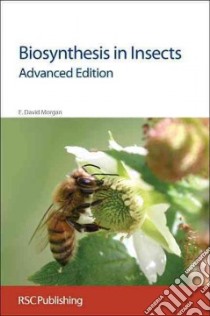- Libreria
- >
- Libri in lingua
- >
- Biologia
- >
- Insetti (entomologia)
Biosynthesis in Insects - 9781847558084
Un libro in lingua di Morgan E. David edito da Royal Society of Chemistry, 2010
- € 52.90
- Il prezzo è variabile in funzione del cambio della valuta d’origine
The secondary metabolites of insects include the important subjects of pheromones, hormones, defensive secretions, cuticular hydrocarbons and metabolites derived from plants. All these subjects have been growing over the past four decades, and are reaching a state of maturity now, where we can begin to see patterns in them and know in which part of the insect body they are produced. Other topics include pigments, luciferin and volicitin. Though aspects of these subjects have been treated in monographs and reviews, there was not, until the first edition of "Biosynthesis in Insects" any book that attempted to cover the whole subject. The book was well received proving the need and interest in the subject, however, the activity in research on insects has meant that the area is expanding rapidly, and new aspects have opened up. It was therefore timely to update and expand that information to make it more useful to research students and investigators, and to bring the threads of the subject together in one place. Thoroughly revised and up-dated, this advanced edition is still the only book on the growing subject of biosynthesis in insects. The new edition is directed more towards researchers and the end of chapter problems have been replaced by references to important research. It covers new developments from recent years including material on molecular biology, genetics, and enzymes. As in the first edition, the book is organized by biosynthetic routes, (fatty acids, polyketides, terpenes, phenyl-C3 types), as far as this system allows. Later chapters are based on type of compound or function, including pigments and venoms. The book is fully illustrated with formulae, reaction schemes, diagrams and illustrations to make clear the subject of the text. It contains many references to important work without overload, and contains suggestions for background and further reading for those not familiar with certain aspects of the subject, which range from mechanistic organic chemistry through biochemistry, chemical ecology, to evolution and molecular biology. Not only insects are considered but where it is available, information about biosynthesis in related arthropods, such as millipedes, centipedes, mites, ticks, spiders and opilionids. The reader has here an introduction to a wide range of insect metabolites, and an in-depth consideration of how, and where they are made. It is a valuable source of information for those working in the fields of chemical ecology, entomology, social organisation, plant protection and pesticides.
Informazioni bibliografiche
- Titolo del Libro in lingua: Biosynthesis in Insects
- Lingua: English
- Autore: Morgan E. David
- Editore: Royal Society of Chemistry
- Data di Pubblicazione: 20 Settembre '10
- Genere: SCIENCE
- ISBN-10: 1847558089
- EAN-13: 9781847558084


